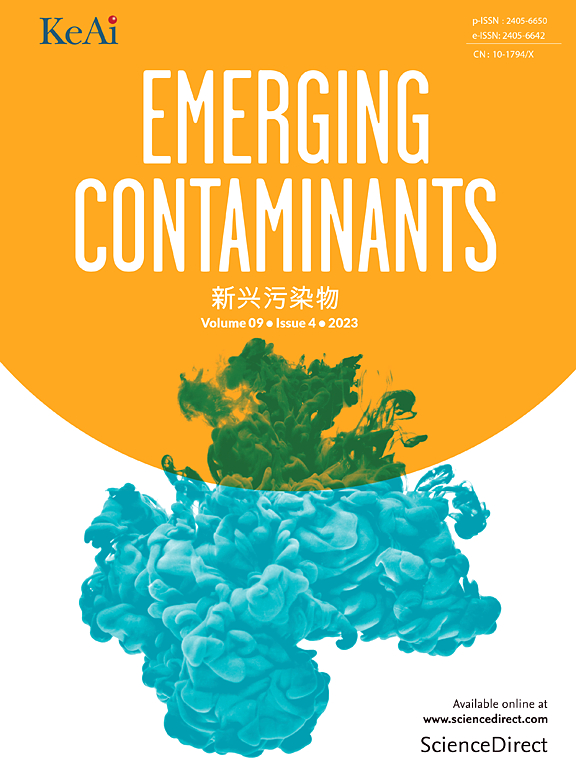Endocrine-disrupting compounds in urban rivers of the southern border of Mexico: Occurrence and ecological risk assessment
IF 5.3
2区 环境科学与生态学
Q1 ENVIRONMENTAL SCIENCES
引用次数: 0
Abstract
The occurrence of seven endocrine-disrupting compounds (EDCs) in four urban rivers on the southern border of Mexico was studied in this work. The selected EDCs were 17β-estradiol (E2), estriol (E3), 17α-ethinylestradiol (EE2), bisphenol A (BPA), bisphenol F (BPF), 4-nonylphenol (4NP) and 4-tert-octylphenol (4TOP). Water samples from the Coatan, Texcuyuapan, Cahoacan, and Coatancito rivers were collected at three different sites on each river and processed by solid phase extraction (SPE). The samples were analyzed by gas chromatography triple quadrupole tandem mass spectrometry (GC-MS/MS) and compounds of interest were identified by dynamic mass reaction monitoring mode (dMRM). Among the target EDCs, E2, BPA, and 4NP were detected in all water samples, with BPA being the most abundant ranging from 4.22 up to 127.96 ng/L. Correlation tests showed significant positive associations between estrogens and BPA, as well as the correlation between alkylphenols and BPA, suggesting common origin emission sources, which were identified as discharges of untreated municipal wastewater. Finally, the estimation of RQ and EEQ values indicated that the presence of E2, E3, EE2, and BPA in all sampled points represents a high risk for aquatic life in these sites, mainly for Texcuyuapan River, where the aquatic organisms may be susceptible to endocrine disruption by chronic exposure to detected compounds.

墨西哥南部边境城市河流中的内分泌干扰化合物:发生和生态风险评估
本文研究了墨西哥南部边境4条城市河流中7种内分泌干扰化合物(EDCs)的含量。选择的EDCs有17β-雌二醇(E2)、雌三醇(E3)、17α-炔雌二醇(EE2)、双酚A (BPA)、双酚F (BPF)、4-壬基酚(4NP)和4-叔辛基酚(4TOP)。在每条河流的三个不同地点采集了来自Coatan、Texcuyuapan、Cahoacan和Coatancito河的水样,并进行了固相萃取(SPE)处理。采用气相色谱-三重四极杆串联质谱(GC-MS/MS)对样品进行分析,采用动态质量反应监测模式(dMRM)对感兴趣的化合物进行鉴定。在所有水样中均检测到E2、BPA和4NP,其中BPA含量最高,范围为4.22 ~ 127.96 ng/L。相关测试显示,雌激素和双酚a之间存在显著正相关,烷基酚和双酚a之间也存在显著正相关,表明它们有共同的排放源,即未经处理的城市污水排放。最后,RQ和EEQ值的估计表明,所有采样点中E2、E3、EE2和BPA的存在对这些地点的水生生物来说都是一个高风险,主要是在德古远坂河,那里的水生生物可能会因长期暴露于检测到的化合物而受到内分泌干扰。
本文章由计算机程序翻译,如有差异,请以英文原文为准。
求助全文
约1分钟内获得全文
求助全文
来源期刊

Emerging Contaminants
Medicine-Public Health, Environmental and Occupational Health
CiteScore
10.00
自引率
6.70%
发文量
35
审稿时长
44 days
期刊介绍:
Emerging Contaminants is an outlet for world-leading research addressing problems associated with environmental contamination caused by emerging contaminants and their solutions. Emerging contaminants are defined as chemicals that are not currently (or have been only recently) regulated and about which there exist concerns regarding their impact on human or ecological health. Examples of emerging contaminants include disinfection by-products, pharmaceutical and personal care products, persistent organic chemicals, and mercury etc. as well as their degradation products. We encourage papers addressing science that facilitates greater understanding of the nature, extent, and impacts of the presence of emerging contaminants in the environment; technology that exploits original principles to reduce and control their environmental presence; as well as the development, implementation and efficacy of national and international policies to protect human health and the environment from emerging contaminants.
 求助内容:
求助内容: 应助结果提醒方式:
应助结果提醒方式:


